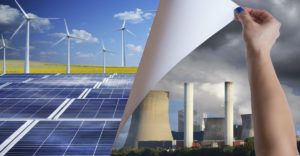
Advertiser Disclosure: At ElectricityRates.com, our number one goal is to help you make better energy decisions. We adhere to strict editorial guidelines, however this post may include references to products offered from our partners.

The oil and gas industries have always had difficulty predicting future market demand. But, today's market is even more difficult to predict with the emergence of renewable sources, which now make up 18% of all power usage in the USA. A brief scan of recent publications on the topic show no consistency in opinion, with some articles stating energy demand is going to stay the same, and some saying it will increase.
Why it is Hard to Predict Energy Demand
The price of fossil fuels has always been hard to predict because it is highly affected by fluctuations in overall economic demand and supply. The industry has a history of major disruptions that lead to destabilization in the global economy. Additionally, political and social change can influence the gas and oil markets. As a result, there has been a push towards increased energy efficiency and a concern for dependency on combustion of fossil fuels.
Predictions of Huge Immediate Spikes
Many sources predict an increase in energy demands, for which there are several reasons. One of the main reasons for potential increased electrical demand is the current push towards electrifying everything as a way to reduced carbon emissions and bring global warming under control. With the increase in awareness of the depleting supply of fossil fuels (such as natural gas and coal), as well as their negative effects on the environment and contribution to global warning, the US is experiencing a move towards electrification. Recent studies on growing electrification show a predictive steady upward trend in total US electricity generation. This means an increase in dependency on the use of electricity to power the technologies we use to function and be productive in daily life.
A report came out this week from the United Nations stating that the earth only has 12 years to dramatically cut the amount of fossil fuel combustion before serious global warming effects take place. According for the Energy Information Administration (EIA), 25% of global energy consumption consists of transportation, specifically mainly light-duty vehicles like personal cars. Therefore, the only way to significantly reduce carbon emissions is by transitioning to electric cars. The number of electric cars being driven globally saw a 54% increase from 2016 to 2017, with over 3 million vehicles on the road today, as reported by the International Energy Agency (IEA). The IEA also reported that the US is second only to China for highest number of electric cars sold, with over 280,000 of such purchased in 2017.
Additionally, homes and businesses will need to be built with energy efficient technologies such as solar panels in order to reduce gas and oil use. Household appliances are likewise seeing an increase in electric power use. In 2014, the Energy Information Administration (EIA) reported that with the exception of within the Northeast, fewer households in the US were choosing natural gas to heat their homes. Instead, people are choosing electric heat pumps to keep them warm. For those living in cooler climates, the existence of fully electrified homes is becoming increasingly more common. This move into electric-powered economies and renewable living may cause a big spike in consumer energy demand.
Another reason for overall increase in electric, transportation, and other sects of energy is that developing nations becoming more industrialized. Around the world, three billion people still cook and heat their homes by burning wood, coal or animal dung. But, as economies become more technologically advanced, the use of utilities will up the demand for wide scale energies in those communities. Other counties that are already developed will use more energy as their middle class increases. This will lead to an increase in electronics and appliances, the construction of larges houses (that require more power to heat and keep the lights on), more cars, and other improvement to standard of living that also require an increase in energy capacity. These developments will specifically be seen in India and China, the two largest nations in the world that are experiencing economic growth.
Predictions of Energy Demand not Increasing
In contrast, other sources predict no immediate increase in global energy demand. Previously, demand for electricity in the US has been increasing since it became mainstream in the late 1800s, up until ten years ago, when the power market stalled out and has not increased since. The US Energy Information Administration (EIA) predicts that the overall electricity use in the US will stay where it has been for many years to come. The reason for this change in a 100 year-old trend is primarily attributed to an overall increase in energy efficiency, as well as consumers and businesses being able to generate their own energy through technologies such as solar and wind power. Increase in energy efficiency is due to higher government standards for energy efficiency, which increased beginning in the 1990s, improved building construction standards and regulations that promote energy conservation, and the replacement of outdated heating systems and other appliances with new energy-efficient models.
Demand for traditional energy sources, such as oil and natural gas, is decreasing as renewable capacities increase and consumers switch the clean resources. Solar and wind made up 62% of new power construction in 2017, and the cost of both are gradually dropping. The number of residential solar panels has been steadily increasing, and actually doubled in 2016 alone. Solar energy generation is both highly supported by the government and cost effective, as well as responsible for increasing home value.
Change in the Energy Mix
Although it may be hard to predict future trends in supply and demand of energy in upcoming years, it is certain that what will change is the ratio of different types of energy sector. Electricity demand will increase as more homes, business and vehicles become battery powered, while consumption of fuel for transportation will likely decrease as transportation systems and technologies become more energy efficient. Expect a higher percent of renewable sources in the global energy mix with each consecutive year.



